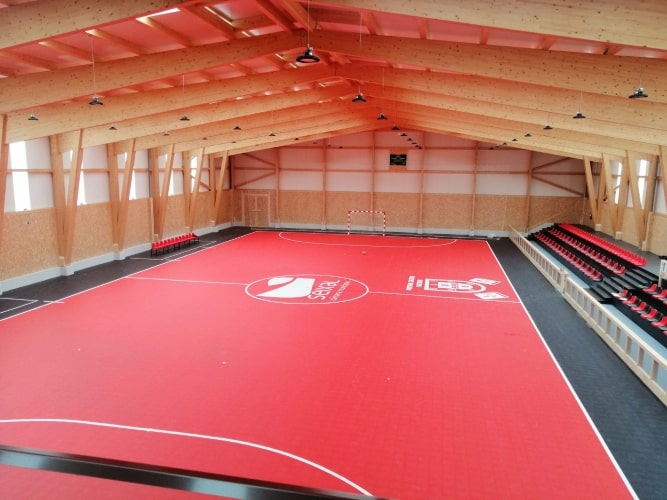
Sports flooring and its importance
Sports flooring is the equipment that is common to all sports. Whether they use goals, posts, baskets or nets, all sports use sports flooring.
As a result, it is one of the pieces of equipment that suffers the most wear and tear over time. And it weighs most heavily on a sports facility’s budget.
From this you can see how important sports flooring is.
Above all, there are two other points that make them so important and that must always be taken into account:
The sports flooring will define the versatility of a sports space, in other words, the choice of flooring will define and condition the sports that can be practised there.
Sports flooring is directly related to injuries to ligaments, joints and the spine. It will also define the level of comfort that athletes will feel when playing sport.
The correct choice of sports flooring is therefore extremely important, as it will strongly condition the use to be made of a sports space.
See our indoor floors here
The sports floor
So what is a sports floor? The answer to this question is both simple and complex.
A “sports floor” is any floor on which sport is practised, but it is complex because not all floors are the same and many floors that call themselves “sports” do not have the necessary characteristics.
Even within “real” sports surfaces, there are quite large differences between different surfaces.
Generally speaking, sports flooring can be characterised in three main areas:
Safety, comfort and protection of athletes – the floor must have characteristics that safeguard and guarantee the safety and comfort of athletes (shock absorption, grip, vertical deformation, etc).
Performance – the surface must have characteristics that guarantee the correct interaction of the ball and other elements with the surface (ball bounce, light reflection, etc).
Durability – the flooring must have characteristics that guarantee its durability in sports use (resistance to impacts, resistance to rolling loads, etc).
In order to standardise these characteristics and guarantee a correct assessment of flooring, the European Union has created two specific standards for sports flooring, which have replaced the previous national standards that each country had.
Two European Standards for sports surfaces are in force.
These standards take the characteristics necessary for a floor to be considered a sports floor and define, depending on whether the floor is for indoor or outdoor use, the minimum and maximum values that these characteristics must have in order for a floor to be approved by the respective standard:
– EN 14904:2006 – Indoor Sports Flooring
– EN 14877:2013 – Outdoor sports flooring
Types of sports flooring
Starting from the two European Standards mentioned above, we can begin to organise the flooring and better understand where the various solutions fit in and what their advantages and disadvantages are.
Flooring available on the market:
Outdoor sports flooring
There are several options, some of which are still widely used, that can’t really be considered sports flooring. These are floors that were quite common a few years ago, but are now obsolete.
They are solutions that do not guarantee the minimum safety or performance requirements demanded of a sports floor.
This type of flooring includes tarmac flooring, cement flooring and porous concrete flooring, which do not fulfil many of the requirements of standard EN 14877:2013, particularly safety requirements.
In outdoor sports flooring, we can identify some of the main solutions:
EPDM and SBR flooring
These are rubber granules or agglomerates specifically for athletics.
They are not suitable for team sports as they do not allow the ball to bounce correctly.
EPDM and SBR flooring greatly reduce the versatility of a sports facility by restricting the sports that can be played there.
Installation is very technical and requires very specific conditions.
Synthetic grass flooring
These are floors that mimic natural grass and are therefore specifically designed for football. They are not suitable for other sports and greatly reduce the versatility of a sports area by restricting the sports that can be played there.
Acrylic resin flooring
Acrylic resin flooring is still widely used due to its relatively low initial price, although the vast majority of them do not fulfil the requirements of the market.

